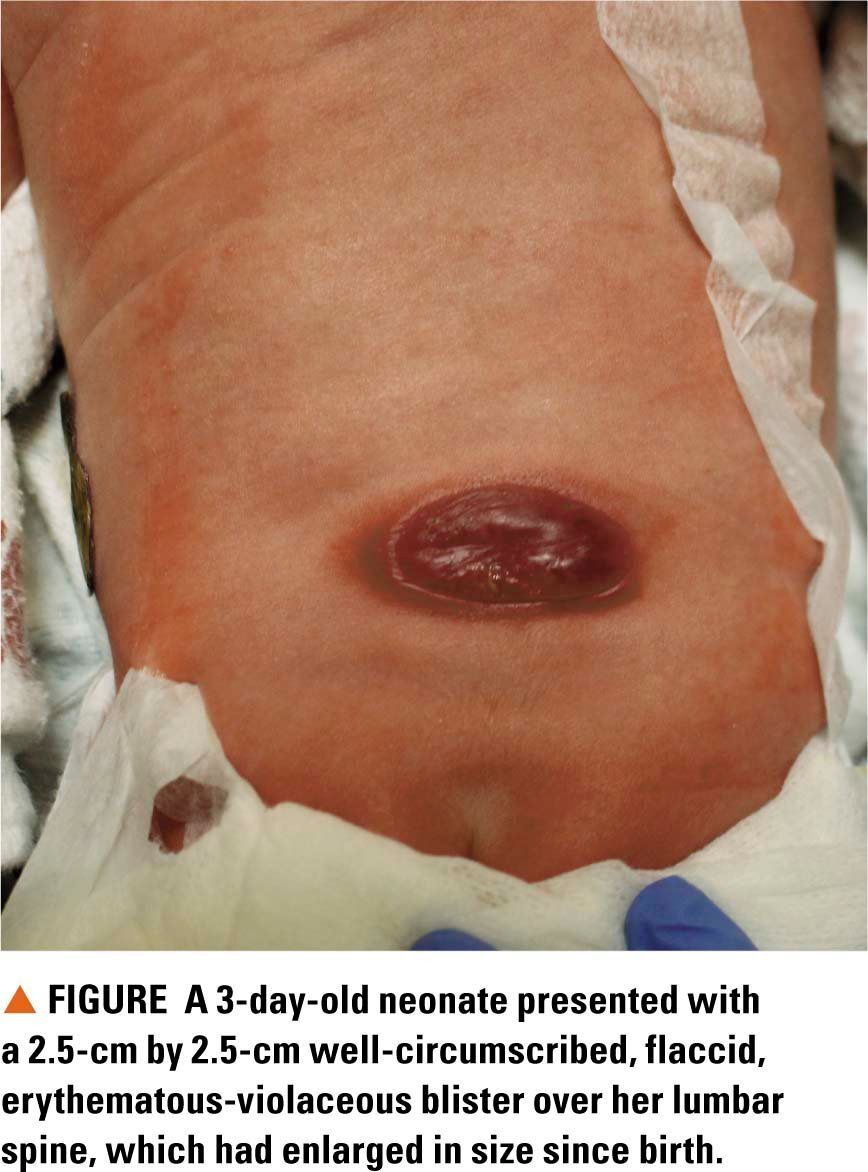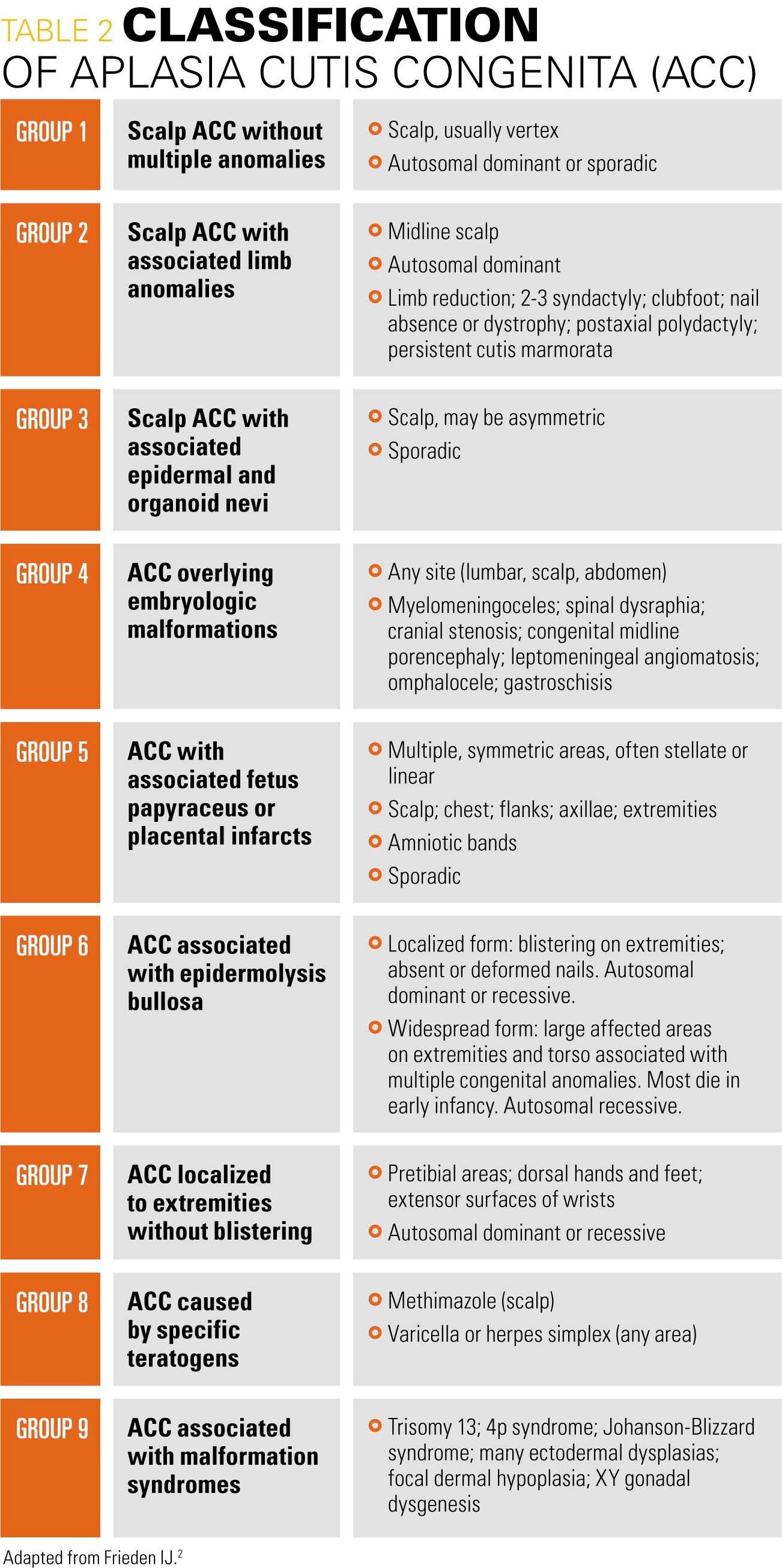Protuberant blister over newborn’s lumbar spine
A healthy full-term newborn presented with a prominent sacral dimple within an oval patch. Ultrasound showed no evidence of spinal anomalies, and the child was discharged home. Three days later, the patch became elevated, red, and moist appearing, and she was brought to the emergency department (ED) for further evaluation of the “growing blister.”

THE CASE
A healthy full-term newborn presented with a prominent sacral dimple within an oval patch. Ultrasound showed no evidence of spinal anomalies, and the child was discharged home. Three days later, the patch became elevated, red, and moist appearing, and she was brought to the emergency department (ED) for further evaluation of the “growing blister.”

Examination and testing
The infant continued to feed and stool appropriately and was able to move her upper and lower extremities equally with no signs of weakness, although she had not voided for 23 hours. Concerned about the enlarging lesion, the patient’s mother brought her to the pediatric ED.
More: Bald area on back of girl's scalp
In the ED, the neonate’s exam was significant for a sacral dimple with a small opening and a 2.5-cm by 2.5-cm erythematous and moist-appearing "protruding sac" on her lower back that oozed serous fluid, thought to be cerebrospinal fluid (CSF). The Neurosurgery service was consulted, who recommended vancomycin and cefepime out of concern for myelomeningocele with external communication. An ultrafast magnetic resonance imaging (MRI) of the brain and lumbar spine was obtained, which was read as most consistent with a noncommunicating cyst in the subcutaneous soft tissues, although communication with the spinal canal could not be excluded. A urinalysis was obtained given the initial concern for obstruction but showed no evidence of infection. The neonate was admitted to the neonatal intensive care unit (NICU) for monitoring and further diagnosis (Table 11-8).

The Dermatology service was then consulted, who described the lesion as a “well-circumscribed flaccid erythematous-violaceous blister” with a thick overlying membrane (Figure). The Dermatology team diagnosed the lesion as membranous aplasia cutis congenital (ACC).
Epidemiology
Aplasia cutis congenita has been estimated to have an incidence of 3 in 10,000 births.4 More than 500 cases have been described in the medical literature,9 but it is believed to be underreported because of its often benign nature. No predilection for race or sex has been reported.4
NEXT: Etiology and pathophysiology
Etiology and pathophysiology
Aplasia cutis congenita most commonly occurs through sporadic mutations, although autosomal dominant inheritance has also been reported.1,5 Mutations in the ribosomal GTPase BMS1 have been identified as one cause of autosomal dominant ACC.4,10 Whereas the etiology and pathogenesis remain unknown, theories involving cutaneous vascular compromise, trauma, infection, and teratogens have been proposed.2,5 Historically, Stephan and colleagues postulated that given the close proximity of vertex ACC to the scalp hair whorl, the tensile forces associated with rapid brain growth may disrupt the overlying skin and underlying mesenchyme at 10 to 18 weeks gestational age.2,11 The tensile forces associated with growth may also affect the separation of the neuroectoderm from the epithelial ectoderm along the mid-dorsal aspect of the embryo at 3 to 5 weeks gestational age.9 However, the causes of aplasia cutis are likely to be as diverse as the clinical presentations of the 9 different groups proposed by Frieden (Table 2).2 For example, group 5 aplasia cutis, associated with fetus papyraceus, has been hypothesized to occur due to hypotension or disseminated intravascular coagulation associated with the loss of a monozygotic twin.5

Discussion
This case represents one of the few published case reports of membranous ACC limited to the lumbosacral area with no associated spinal dysraphism or other malformations.2 Aplasia cutis of the lumbosacral spine is rare and published case reports have largely focused on its association with spinal dysraphisms such as myelomeningocele and diastematomyelia, faun tail nevus, and fetus papyraceus.2,9,12-14 In contrast, this case does not fit any of the 9 groups of ACC described by Frieden.2 Group 4 ACC involves the lumbar skin but has underlying embryologic malformations such as meningomyelocele or other spinal dysraphism.2 Group 5 ACC can involve the trunk, but has multiple symmetric lesions and is typically associated with fetus papyraceus.2 An isolated lumbosacral ACC lesion with no associated abnormalities is unusual and sparsely described in the medical literature. Perhaps this is why this neonate’s lesion was initially diagnosed as myelomeningocele instead of ACC.
Next: Itchy blisters bother a 12-year-old girl
As this case illustrates, the diagnosis of membranous ACC can be easily missed, particularly when lesions are located in areas other than the vertex scalp. Early dermatology consults may aid in faster diagnosis. However, any midline lumbosacral cutaneous abnormality can be a marker of spinal dysraphism, and over half of reported cases of spinal dysraphism have an associated dermatologic finding.13,15 For this reason, ultrasound and rapid MRI should be performed for all midline lumbosacral cutaneous lesions to rule out spinal cord malformation and prevent neurologic morbidity.9 An MRI is also indicated for any ACC lesions with a hair collar sign, as hypertrichosis has been associated with a 20% to 50% incidence of spinal cord malformations.1,9
Treatment and management
Membranous ACC is usually self-limiting and self-heals with scarring. Careful wound care is essential until the lesions are completely healed. In newborns, it is essential to determine the depth of the lesion, prevent infection, and rule out associated anomalies such as spinal dysraphism. Simple surgical excision can be performed for most lesions during later childhood, although larger lesions may require staged excision with tissue expanders.1
Patient outcome
On the fourth day of life, the patient’s midline cyst was removed in the operating room by Plastic Surgery and Neurosurgery with a midline closure. No communication with the spinal canal was appreciated during surgery. Final pathology results were consistent with congenital epidermal sinus/cyst with associated inflammation and granulation tissue.
The neonate was discharged home on the fifth day of life with instructions to follow up with Neurosurgery and Plastic Surgery. Over the next 4 weeks, the infant was followed by Plastic Surgery and her wound displayed excellent healing with an Aquacel dressing.
References
1. Cohen BA. Pediatric Dermatology. 4th ed. Philadelphia, PA: Saunders Elsevier; 2013.
2. Frieden IJ. Aplasia cutis congenita: a clinical review and proposal for classification. J Am Acad Dermatol.1986;14(4):646-660.
3. Burkhart CN, Morrell D, Goldsmith LA, Esterly N. Aplasia cutis congenita: skin in infant/neonate. In: Goldsmith LA, ed. VisualDx. Rochester, NY: VisualDx; 2017. Available at: https://www.visualdx.com/visualdx/diagnosis/aplasia%20cutis%20congenita?diagnosisId=51132&moduleId=23. Updated March 2, 2015. Accessed December 12, 2017.
4. Wan J. Aplasia cutis congenita. Medscape. Available at: http://emedicine.medscape.com/article/1110134-overview. Updated May 12, 2017. Accessed December 12, 2017.
5. Morrow D, Schelonka R, Krol A, Davies M, Kuang A. Type V aplasia cutis congenita: case report, review of the literature, and proposed treatment algorithm. Pediatr Dermatol. 2013;30(6):e208-e213.
6. Botto LD, Moore CA, Khoury, MJ, Erickson JD. Neural-tube defects. N Engl J Med. 1999;341(20):1509-1519.
7. Goldsmith LA, Bernhard JD, Stein S, et al. Lumbosacral skin lesion: skin in child. In: Goldsmith LA, ed. VisualDx. Rochester, NY: VisualDx; 2017. Available at: https://visualdx.com/visualdx/diagnosis/lumbosacral-skin-lesion?moduleId=12&diagnosisId=54945. Updated February 11, 2015. Accessed December 12, 2017.
8. Parker LA, Montrowl SJ. Neonatal herpes infection: a review. Medscape. Available at: http://www.medscape.com/viewarticle/472408_3. Published April 2004. Accessed December 12, 2017.
9. Ustüner P, Dilek N, Saral Y, Ustüner I. Coexistence of aplasia cutis congenital, faun tail nevus, and fetus papyraceus. J Dermatol Case Rep. 2013;7(3):93-96.
10. Marneros AG. BMS1 is mutated in aplasia cutis congenita. PLoS Genet. 2013;9(6):e1003573.
11. Stephan MJ, Smith DW, Ponzi JW, Alden ER. Origin of scalp vertex aplasia cutis. J Pediatr. 1982;101(5):850-853.
12. Kumar P, Gharami RC. Aplasia cutis congenital on lumbosacral area. Indian Dermatol Online J. 2014;5(1):103-104.
13. Chander R, Jain A, Jaykar K, Garg T, Anand R. Faun tail nevus with aplasia cutis congenita. Pediatr Dermatol. 2009;26(4):484-485.
14. Higginbottom MC, Jones KL, James HE, Bruce DA, Schut L. Aplasia cutis congenita: a cutaneous marker of occult spinal dysraphism. J Pediatr. 1980;96(4):687-689.
15. Tavafoghi V, Ghandchi A, Hambrick GW Jr, Udverhelyi GB. Cutaneous signs of spinal dysraphism. Report of a patient with a tail-like lipoma and review of 200 cases in the literature. Arch Dermatol. 1978;114(4):573-577.
Recognize & Refer: Hemangiomas in pediatrics
July 17th 2019Contemporary Pediatrics sits down exclusively with Sheila Fallon Friedlander, MD, a professor dermatology and pediatrics, to discuss the one key condition for which she believes community pediatricians should be especially aware-hemangiomas.
Itchy skin associated with sleep problems in infants
September 27th 2024A recent study presented at the American Academy of Pediatrics 2024 National Conference & Exhibition, sheds light on the connection between skin conditions and sleep disturbances in infants and toddlers, highlighting itchy skin as a significant factor, even in the absence of atopic